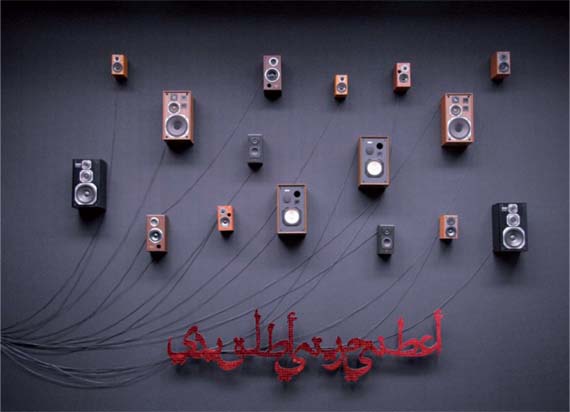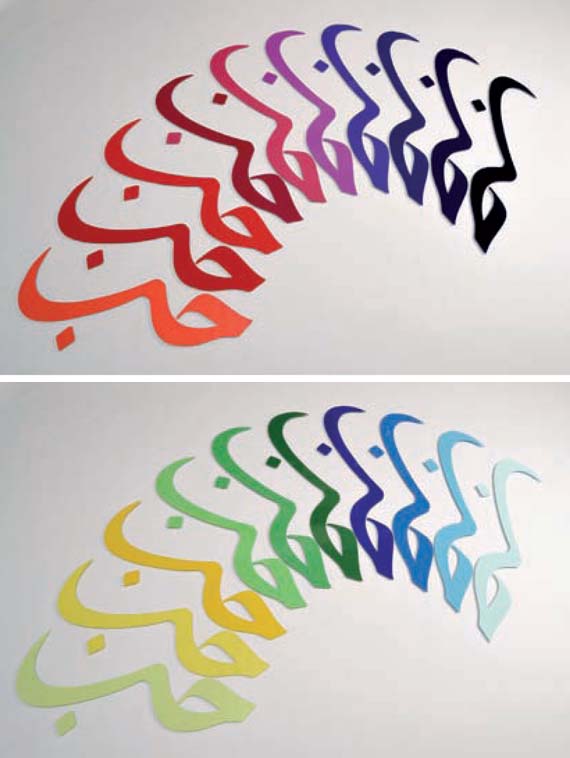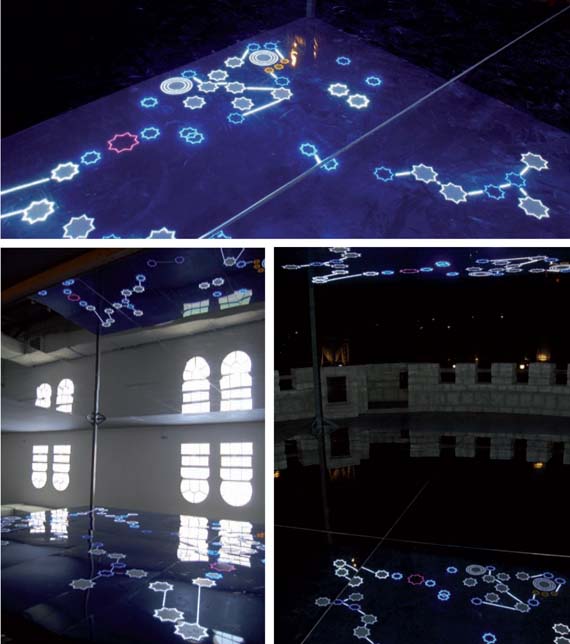‘Mirage’ by Zoulikha Bouabdellah at Sabrina Amrani Art Gallery
Jun 12, 2011 Exhibition
Photo above: “Is your love darling just a mirage?â€. 2011 / Photo courtesy of Sabrina Amrani Art Gallery
Bouabdellah explains the motivations that prompted her to develop Mirage: “In a few months, history has changed its side. It is now being written in the south, across the Mediterranean, where after Tunisian and Egyptian revolutions, civil war in Libya and the rising of Syrian people, the spreading revolution has arrived to Bahrain and Yemen. And, while Morocco launches unprecedented political reforms, Algeria is committed to strengthening the democratic process. How will all this end up? No one can say with certainty”, says the artist. Her only certainty at the moment is that, as in every revolutionary process, images will perdure converted into icons. Bouabdellah found her own: “a picture of a Mirage aircraft of the Gaddafi’s Air Force”. Shot down in flight by rebel forces, the image showed the aircraft with its beak pointing towards the Libyan soil. “The hit didn’t come to be seen but it is significant and significative: the dictator is no longer invincibile”, concludes the artist.
This image, chosen for the Mirage (I, II, III, IV and V) series and for the triptych “Is your love darling just a mirage?â€, “brings us back to the ideals of the revolution”. With these pieces, Bouabellah lays down some questions: “Will they inspire the continuation of the story, or agitated as broken promises, will they remain in the state of mirages, as a more or less distorted picture of what was a real ideal?”. In between what is here (the revolution) and what will arrive (the democracy), the artist has found in the military aircraft Mirage a perfect image. In the exhibition designed for Sabrina Amrani, the idea takes the form of a geometric composition inspired by the Arabic artistic repertoire. As the concepts that underlines the tradition of the tiles, the Mirage artworks teach the unattainable in an experience that exceeds the contemplation and push to interpretations. “Just as the passage of this plane is difficult to discern, due to the physical phenomenon of refraction searched purposely by the builders of the aircraft, the shapes of Mirage combines a series of rhythmic movements that the eye can not see accurately. These are shapes that attract actors and spectators of the history with this lack of certainty that characterizes each revolutionary episode”, says Bouabdellah.

“Mirage I” / Photo courtesy of Sabrina Amrani Art Gallery

“Mirage IV” / Photo courtesy of Sabrina Amrani Art Gallery
The exhibition is completed with Set me free from my chains, a deviation of the original meaning of the phrase sung by Umm Kulthum, the Egyptian grand dame of the Arabic song. This cry of a woman, chained for the love and eager to regain her freedom, here becomes a revolutionary slogan, a universal formula for all the oppressed.

“Set me free from my chainsâ€, 2009 / Photo courtesy of Sabrina Amrani Art Gallery
is French and Algerian although was not born in France nor in Algeria, but in Moscow, where his parents studied. Her personal history and her work, developped in the tension between groups and different cultures that were juxtaposed, crossed and confronted in time: the family emigrated to France from Algeria when Zoulikha was 16 years old, in the early 90’s. At that time, Algeria lived the civil war years. Zoulikha Bouabdellah constantly explores the interstices between “them and us” between the North and South, Europe and Africa, Christianity and Islam and fundamentally, the gap between men and women, the gap between what is visible and what is not said, the split between pleasure and pain. The artist often focuses on Arab and Islamic contributions in astrology, mathematics, religion and aesthetics with a disturbing ability to forge new meanings to expressions and recurring motifs which repeat, relate, overlap and reveal new and very modern meanings that intuit the interaction of cultures.
Another of her most recognized work is Walk on the sky – Pisces, which won the ArtDubai Abraaj Capital in 2009, the highest prestigious award in the Arab world. In this ambitious work, a three-dimensional design, Zoulikha embodied the constellation Pisces from conception of the astronomer Abd al-Rahman al-Sufi (903-986). The piece made use of the polygonal star, one of the symbols most depicted in Arabic art and architecture throughout the ages, and closed the space with a floor of mirror: the same that the Queen of Sheba crossed for her encounter with the King Solomon. This reference, present in the Bible and the Qur’an reflects the dialogue between cultures present in the work of the artist.
With these works, the artist ensures is not searching subversion, although she recognizes that “the transgression is an essential component of modernity, that allows us to depart from the beaten path and change the codes to look beyond”. However, Bouabdellah’s work seems to look for the subtlety in the message and a positive view of the underlying conflict.

“Love - Red to blueâ€. 2009 and “Love - Yellow to blueâ€. 2009 / Photo courtesy of Sabrina Amrani Art Gallery

“Walk on the sky -Piscesâ€. 2009 / Photo courtesy of Sabrina Amrani Art Gallery

“Le Rouge et noirâ€. 2008 / Photo courtesy of Sabrina Amrani Art Gallery
The promoter of this new space for contemporary art in Madrid is Sabrina Amrani. French of Algerian origin, she impulses a gallery project marked by one word: dialogue, to see and to listen to others. Therefore, the distinctive signs of the gallery Sabrina Amrani are proposals that invite to think on the individual, the society or space. “Political or social thoughts: the artist’s own, always individually”, Amrani said. The gallery collaborates with artists José Luis Bongore, Elvire Bonduelle or Zoulikha Bouabdellah, among others. Established and emerging artists of many nationalities will come together in her space because, as stated by the gallerist: “Nor art, much less dialogue, have borders.” However, Amrani acknowledges that the project will pay particular attention to the new voices that are emerging in the Middle East and North Africa region.
Comments
Jun 12, 2011 - 14:35:02
Great
Add a comment